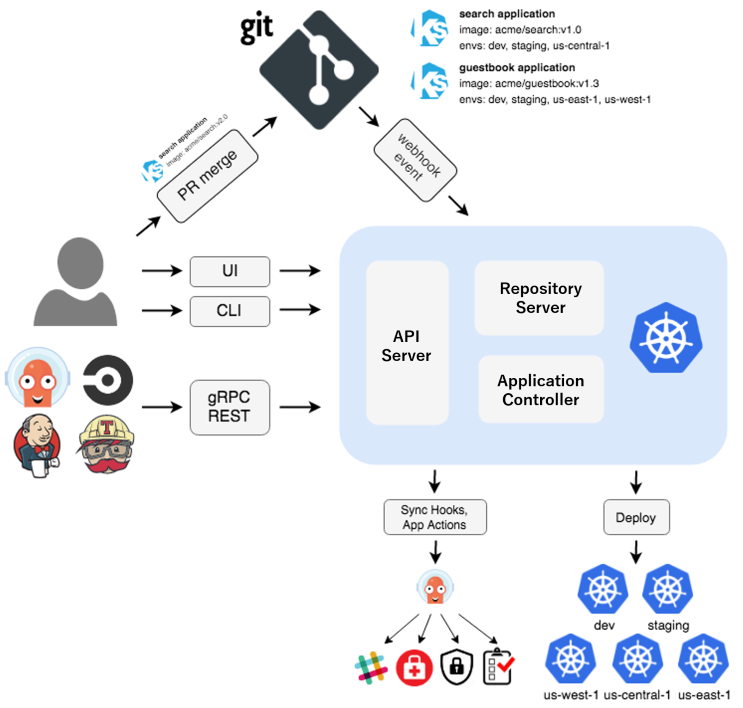ArgoCD: Driving GitOps to the Next Level
ArgoCD is a continuous deployment tool used for Kubernetes. It is based on the GitOps principle. Argo CD has the ability to publish updated code straight to Kubernetes resources by pulling it from Git repositories. It allows developers to handle application updates and infrastructure settings in a single system.
Why use ArgoCD ?
Version control should be applied to environments and application configurations. The lifecycle management and deployment of applications should be automated, auditable, and simple to understand.
Understanding GitOps :
An approach to managing application configuration and infrastructure is called GitOps. It makes use of Git, a popular open source version management system for software development projects. Infrastructure as code technologies, upon which GitOps is built, are capable of autonomously restoring the infrastructure to a desired condition given a configuration file. A pull request is a fundamental step in the GitOps process. Pull requests are used to introduce new versions of a configuration, which are then automatically deployed after merging with the main branch in the Git repository.
ArgoCD Processing Chain :
- When an application is modified, a developer pushes an updated version of the Kubernetes resource definitions to a Git repository.
- A fresh container image is saved to a registry as a result of the continuous integration being initiated.
- By submitting a pull request, a developer modifies Kubernetes manifests, which can be generated automatically or manually.
- After reviewing the pull request, the modifications are incorporated into the main branch. This sets off a webhook that notifies Argo CD of the modification.
- After cloning the repository, Argo CD contrasts the application state with the Kubernetes cluster’s current state. It modifies the cluster configuration as needed.
- Until the desired configuration is reached, Kubernetes uses its controllers to balance the necessary adjustments to cluster resources.
- Argo CD keeps track of developments and notifies users when the application is synchronized with the Kubernetes cluster.
- ArgoCD also operates in the opposite direction, keeping an eye on modifications to the Kubernetes cluster and removing them if they don’t align with the Git configuration as it is.
How does Argo CD make it happen?
- GitOps agent—Argo CD is in charge of releasing updated code straight to Kubernetes resources after retrieving it from Git repositories. In a single system, it controls both application updates and infrastructure configuration.
- Custom Resource Definitions (CRD)—Argo CD runs inside a Kubernetes cluster in its own namespace. It offers its own CRDs that add functionality to the Kubernetes API and enable declarative definition of the intended application state. Argo CD uses its CRDs to apply the modifications inside its designated namespace in accordance with the guidelines found in a Helm or Git repository.
- CLI—With just a few easy commands, one can build YAML resource definitions using Argo CD’s robust CLI. For example, the Argo CD app create command eliminates the requirement for manual YAML writing by allowing you to define a proper Application object that specifies your application and set a few options.
- User Interface— The distinctive feature of Argo CD is its easy-to-use web-based user interface, which enables you to describe an application and request that Argo CD generate the necessary YAML configurations.
Working of ArgoCD :
By comparing each application’s present state with the state that ought to have been reached (as specified in the Git repository), Argo CD employs a Kubernetes controller to monitor every application that is operating. Any deployed program whose live state deviates from the intended state is referred to as OutOfSync.
Argo CD identifies and shows the differences, and uses several actions in conceiving and changing the live state to the target state, which could be by different means. Over any changes to targeted state which reside in the Git repository, such changes can be made in the environments in question by switching on the appropriate features.

Getting Started with ArgoCD installation :
Step 1 : Creating namespace
kubectl create namespace argocd
Step 2 : Execute this command
kubectl apply -n argocd -f https://raw.githubusercontent.com/argoproj/argo-cd/stable/manifests/install.yaml
This command installs or updates ArgoCD in the argocd namespace by applying the resources defined in the ArgoCD installation YAML file from the specified URL.
Features Of ArgoCD :
- Prometheus Metrics.
- Deploying applications to specified target environments without human intervention.
- Ability of managing and deploying to multiple clusters.
- Analyzing health status of application resources.
- Provides CLI for automation and CI integration.
- Provides access tokens for automation.
- API calls and application events have audit trails.
Conclusion
In conclusion, it may be said that ArgoCD is an efficient tool that simplifies the process of continuous delivery for Kubernetes apps. It adopts a GitOps approach which encompasses a declarative way of deploying applications that guarantees consistency in various domains with assured delivery. Organizations want to make their deployment processes more effective, which is why it is in demand due to such features as rollback, automatic sync, and plenty of dashboards. ArgoCD will also enhance minimization of human errors, clear audit checks and maximize quick turnaround time on projects in software development.


